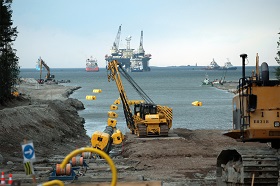The US visit by Serbian Prime Minister Aleksandar Vucic must be considered primarily in the context of the Individual Partnership Action Plan between the Republic of Serbia and NATO), signed in January 2015. This comprehensive document established a framework for the parties’ collaboration and step-by-step alignment in all areas: military technical cooperation; regional cooperation; economic, legal and law enforcement reform; ethnic issues and EU integration. The visit aims, therefore, to elaborate on the agreed plan.
The US visit by Serbian Prime Minister Aleksandar Vucic must be considered primarily in the context of the Individual Partnership Action Plan between the Republic of Serbia and NATO), signed in January 2015. This comprehensive document established a framework for the parties’ collaboration and step-by-step alignment in all areas: military technical cooperation; regional cooperation; economic, legal and law enforcement reform; ethnic issues and EU integration. The visit aims, therefore, to elaborate on the agreed plan.
According to the Serbian government's press service, the first part of the agenda (for the first day of the visit) dealt with economic issues: the Prime Minister met with representatives of US corporations and local Serbian diaspora leaders. Given the Serbian government’s announcement about the upcoming privatization of 526 Serbian industrial assets, including 17 strategic ones made on May 29th, the Serbian party is likely to have an elevator pitch ready for potential investors. On the same day, in a notable and symbolic step, Serbia and the US signed an air traffic agreementenabling direct trans-Atlantic flights between the two countries.
Another part of the visit’s agenda deals with the current international situation, including such topics as: the Macedonian events, Belgrade-Moscow relations in light of the Ukrainian crisis (2015 is the year of Serbian presidency in the OSCE), and Belgrade’s relations with Kosovo and Albania (the Serbian PM has just returned from Tirana, where he called upon the region’s business community to improve their ‘economic cooperation’. Vucic will undoubtedly appreciate the opinions and ideas expressed by US Vice President Biden, Deputy Secretary of State Blinken, and Senator McCain.
If successful, these negotiations could be a starting point for a new stage in Serbia’s EU integration. The Individual Plan envisions Serbia finalizing the demarcation of its borders with its neighbours by the end of 2015, which should add some clarity to Kosovo’s status. The Serbian government is likely to step up its military involvement in UN and EU peacekeeping operations, enhancing the country’s integration into the western security. Favourable conditions have now emerged for pushing through such decisions. Serbia is a parliamentary republic, with Vucic’s coalition holding a strong majority in the parliament (158 seats of 250). Vucic himself is known for his individualism and penchant for sharp political actions and statements, supported by the media, – Bonapartesque moves occasionally helpful in times of changes.
Finally, a few words about the gas issue. The scene for Vucic’s visit was set by President Nicolic’s loud statements ruling out the option of the Turkish Stream and Vucic’s own call to “reduce dependency on Russian gas”. And, although it does look like a direct threat to Russian investments in the region, Serbia likely has an ulterior motive. Looking at the map of the Trans Adriatic Pipeline (TAP), Gazprom’s alternative route, it is clear that the initial plan had it crossing Turkey, Greece and Albania, leaving out Serbia, the central element of Russian transit projects. Serbia can only count on a branch of the main line – built at its own expense. Belgrade is thus signalling that it would accept the American terms in exchange for at least partial coverage of its costs.





